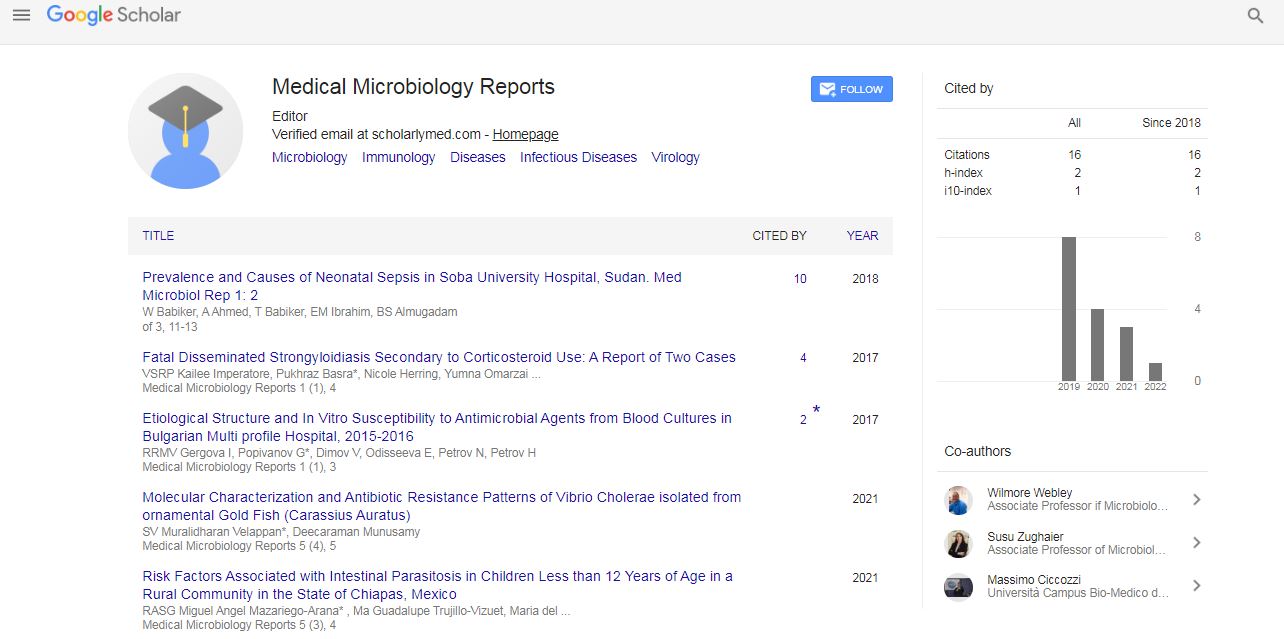Opinion Article, Med Microbiol Rep Vol: 6 Issue: 3
Toxicity of Fumonisin isolated from Maize Kernels
Rojas Bourhis*
Department of Plants and Crops, Faculty of Bioscience Engineering, Ghent University, Ghent, Belgium
*Corresponding Author: Rojas Bourhis
Department of Plants and Crops, Faculty of Bioscience Engineering, Ghent University, Ghent, Belgium
Email: rgbourhis@gmail.com
Received date: May 03, 2022, Manuscript No: MMR-22-13496;
Editor assigned date: May 06, 2022, PreQC No. MMR-22-13496 (PQ);
Reviewed date: May 16, 2022, QC No. MMR-22-13496;
Revised date: May 27, 2022, Manuscript No. MMR-22-13496 (R);
Published date: June 03, 2022, DOI: 10.4172/mmr.1000024
Citation: Bourhis R (2022) Toxicity of Fumonisin isolated from Maize Kernels. Med Microbiol Rep 6:3.
Keywords: Enzymatic
Description
Fumonisins are mostly created by F. verticillioides and F. proliferatum and other Fusarium spp. The variety Fusarium, having a place with the family Nectriaceae, can be found as saprophytes in soil and plants around the world. Fusarium spp. colonize to the rhizospheres of plants and afterward in this manner go into the plant framework. Besides, F. verticillioides and F. proliferatum are known to be the most widely recognized microbes of maize. The yields, yet additionally numerous well known fancy plants are habitually gone after by various Fusarium species, viz., F. oxysporum, F. foetens, F. hostae, and F. redolens at different phases of creation. Fusarium, then again, taints orchids in both pathogenic and non-pathogenic structures. The non-pathogenic structures are either decomposers or in common connection where they help in the germination of seeds and the variety improvement of seedlings. The non-pathogenic structures additionally help to alleviate the contamination of Fusarium shrivel on different yields. Soils liable for stifling Fusarium wither are viewed as predominant in the Fusarium spp. like F. oxysporum and F. solani which are of rural significance. The Fusarium species contaminate maize and produce fumonisins basically at the pre-gathering stage. Moreover, fumonisin creation has been seen during the post-gather time frame; nonetheless, under unfriendly states of capacity. Dietary openness of fumonisins can prompt a few hurtful results in both homestead and exploratory research center creatures. For instance, these poisons are answerable for leukoencephalomalacia in ponies, pneumonic edema disorder in pigs, hepatotoxicity and nephrotoxicity in rodents, and apoptosis in numerous different kinds of cells.
Toxicity of Fumonisins
Albeit the fumonisins were found as of late, the poisonousness of corn polluted by F. moniliforme has been indisputably factual for in excess of 100 years. An infection of livestock known as "rotten corn harming" or "blind falters" was first portrayed in the United States in 1850. The causative specialist stayed obscure until Sheldon and others distinguished F. moniliforme and related it with an episode of rotten corn infection of ponies, cows, donkeys, swines, and chickens in Nebraska. The most emotional sign of rotten corn sickness is equine leucoencephalomalacia (ELEM), a lethal cerebrum infection of ponies, jackasses, donkeys, and hares. In ponies, this sickness commonly brings about death inside a couple of hours to multi week. In 1971, ELEM was created by taking care of ponies material tainted with an unadulterated culture of F. moniliforme, which solidly settled this organism as the causative specialist. The South African examination bunch that was quick to distinguish and portray the fumonisins was additionally quick to exhibit that unadulterated fumonisin B1 (FB1) can create ELEM in a pony. Ponies give off an impression of being uncommonly delicate to fumonisins. Overviews of feed tests related with flare-ups of ELEM in North America, South America, and Africa observed FB1 levels going from 0.2 to 126 µg/g feed. Analyses to decide the base harmful portion of fumonisins demonstrate that horses consuming normally tainted takes care of containing FB1 at levels as low as 8 µg/g feed are in danger of creating ELEM. ELEM might be the most sensational, however it is absolutely by all accounts not the only creature illness related with utilization of feed polluted with F. moniliforme. A 1981 investigation of the oral harmfulness of F. moniliforme.
Risk Assessment of Fumonisins
Ponies are the most delicate species to fumonisin poisonousness with normally happening infection happening around the world. The objective organs in the pony are heart, focal sensory system and liver. The sickness disorder was named leukoencephalomalacia because of the sort and conveyance (leuko = white matter) of the most unmistakable injury in the cerebrum. Equids are the main species where fumonisins instigate this injury. A few audits of ELEM are accessible. Beginning of illness might happen as soon as 7 days after an adjustment of diet, however generally following 14-21 days; at times beginning might be postponed 90 days or more. Flare-ups that influence a few ponies on a similar homestead are normal for extra data on flare-ups. In 1901 through 1902, more than 2000 ponies passed on in the USA because of ELEM and in 1934 through 1935 north of 5000 ponies kicked the bucket in the territory of Illinois alone. Huge quantities of flare-ups were accounted for in the USA during the 1980s, particularly following the weighty defilement of the 1989 maize crop. Extra episodes of ELEM were accounted for during the 1990s from the USA and Hungary. Episodes keep on happening every year in the USA. In a given flare-up, the general horribleness is for the most part low; under 0.25; yet mortality as a rule approaches 1.00 in impacted creatures.
The uncommon enduring creatures will as a rule have super durable neurological sickness. ELEM additionally happens in jackasses. Two conditions have been portrayed in ponies with normally happening infection because of F. verticillioides or F. proliferatum disease of maize, the neurotoxic (which is named ELEM) and hepatotoxic structures. These structures might show up freely or simultaneously. In the field, high-portion openness is remembered to improve the probability of the hepatotoxic structure, with the more oftentimes experienced lower dosages leaning toward the neurotoxic structure, ELEM. The clinical course of ELEM is for the most part short with an intense beginning of signs followed by death inside the space of hours or days. Diminished feed consumption, gloom, ataxia, visual deficiency, and delirium are accounted for. Anorexia happens because of glossopharyngeal loss of motion, and loss of motion of the lips and tongue, with loss of capacity to handle and bite food. Incoordination, revolving around, ataxia, head squeezing, stamped trance, and hyperesthesia are normal, as are hyperexcitability, abundant perspiring, craziness, and spasms. Intensely impacted creatures frequently progress through the hyper and burdensome phases of the condition inside 4-12 h of beginning and become supine and incurable. Passing may likewise happen without clinical signs being noticed.
 Spanish
Spanish  Chinese
Chinese  Russian
Russian  German
German  French
French  Japanese
Japanese  Portuguese
Portuguese  Hindi
Hindi 
